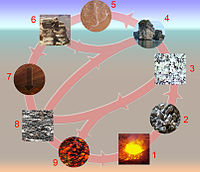
Photo from wikipedia
Low-pressure/high-temperature metamorphic rocks exposed in the western part of the Ryoke belt (Iwakuni–Yanai area, SW Japan) include a section with increasing temperature conditions from 425 to 880 C. We use… Click to show full abstract
Low-pressure/high-temperature metamorphic rocks exposed in the western part of the Ryoke belt (Iwakuni–Yanai area, SW Japan) include a section with increasing temperature conditions from 425 to 880 C. We use this setting to explore the evolution of monazite grain size, texture and composition, and variations in the whole-rock composition of 11 metapelite, metapsammite or metachert samples collected along the metamorphic field gradient. Monazite grain size increases with rising metamorphic grade, regardless of the whole-rock composition. From lowto high-grade conditions we infer: (1) the initial nucleation of monazite aggregates after allanite ( 425 C); (2) monazite coarsening and coalescence driven by incipient monazite recycling; that is, dissolution of small grains to grow larger ones by Ostwald ripening (500–600 C); (3) a first major recycling stage enhanced by fluid liberation owing to muscovite breakdown (600–630 C); (4) a second recycling stage assisted by an increase in the proportion of anatectic melt owing to biotite breakdown (> 850 C). A succession of four compositional domains is recognized in monazite. We emphasize the usefulness of comparing their Ce/ThMnz, Ce/YMnz and Th/UMnz molar ratios with those derived from whole-rock analyses to constrain the origin of each domain. Domain I, with variable ratios, reflects the progressive transfer of Th 6 U from allanite to monazite at low-grade conditions. Domain II, with Ce/ThMnz matching the whole-rock values, indicates growth under rock(decimetre)scale equilibrium conditions. Domains II and III, with Th/UMnz and Ce/YMnz departing from the whole-rock values, record the competition with zircon (for U) and garnet (for Y) during growth at peak P–T conditions. Domain IV points to Y supply by garnet resorption during retrograde chloritization (< 550 C). In the highest-grade sample, zircon grains included in garnet or cordierite show metamorphic rims with sillimanite and Si-rich inclusions. These rims formed at suprasolidus conditions (650–880 C) and yield Pb/U ages of 103–97 Ma (6 5 Ma), which bracket the timing of high-temperature metamorphism. Monazite dating by electron microprobe and laser ablation inductively coupled plasma mass spectrometry reveals two age groups. For domains I–III, some relatively old Pb/U ages (99–95 6 3–5 Ma) represent minimum estimates for the timing of prograde to peak metamorphism, whereas the similar oldest Pb/U age for domain IV VC The Author(s) 2018. Published by Oxford University Press. All rights reserved. For permissions, please e-mail: [email protected] 1109 J O U R N A L O F P E T R O L O G Y Journal of Petrology, 2018, Vol. 59, No. 6, 1109–1144 doi: 10.1093/petrology/egy056 Advance Access Publication Date: 11 June 2018
Journal Title: Journal of Petrology
Year Published: 2018
Link to full text (if available)
Share on Social Media: Sign Up to like & get
recommendations!